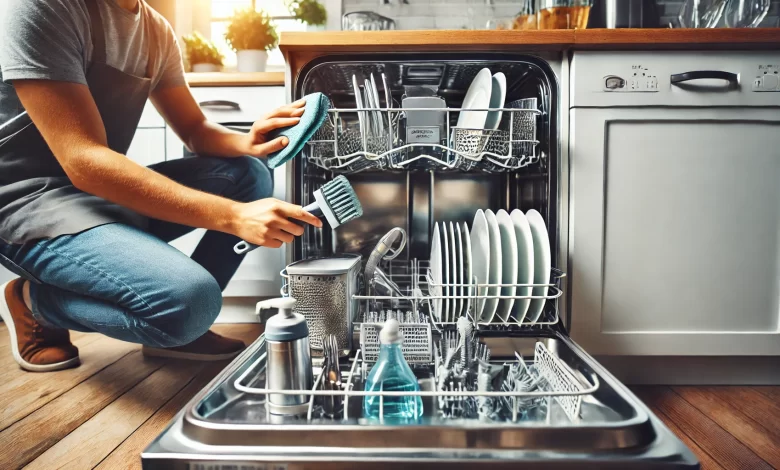How to Fix Dishwasher Not Cleaning Dishes Properly
Simple DIY Solutions: How to Fix a Dishwasher Not Cleaning Dishes Properly

Having a dishwasher is a great convenience, but it can quickly become frustrating when it stops doing its job effectively. If your dishwasher isn’t cleaning dishes properly, you’re not alone. This is a common issue, but the good news is that in most cases, you can fix it yourself without calling a professional. In this article, we’ll cover the reasons why your dishwasher might not be cleaning as it should and explain how to fix a dishwasher not cleaning dishes properly with step-by-step solutions.
Table of Contents
Common Causes for Dishwasher Not Cleaning Dishes Properly
Before diving into how to fix a dishwasher not cleaning dishes properly, it’s essential to understand the most common reasons this issue occurs. Here are some potential causes:
- Clogged spray arms: The spray arms are responsible for distributing water during the wash cycle. If these are clogged, the water won’t reach your dishes effectively.
- Dirty filters: If the filters are dirty or clogged, it can prevent water from flowing properly, leading to poorly cleaned dishes.
- Improper loading: Overloading the dishwasher or placing items incorrectly can block the spray arms and stop water from reaching the dishes.
- Low water temperature: Water that isn’t hot enough won’t clean effectively. The ideal temperature for cleaning dishes is around 120°F (49°C).
- Detergent issues: Using the wrong detergent or too much of it can leave residue on your dishes.
- Hard water buildup: Mineral deposits from hard water can build up in your dishwasher and affect its performance.
- Blocked or broken inlet valve: The inlet valve is responsible for letting water into the dishwasher. If it’s faulty, the machine won’t fill properly, affecting its cleaning ability.
Step-by-Step Guide: How to Fix Dishwasher Not Cleaning Dishes Properly
Now that we’ve identified some potential causes, let’s look at how to fix a dishwasher not cleaning dishes properly.
1. Clean the Spray Arms
The spray arms in your dishwasher are crucial for spraying water onto the dishes. Over time, they can become clogged with food particles, soap residue, or mineral buildup.
Steps:
- Remove the spray arms by unscrewing or unclipping them (check your dishwasher’s manual for specific instructions).
- Check each spray arm hole for blockages. Use a toothpick or small brush to clear out any debris.
- Rinse the spray arms under warm water to ensure all clogs are removed.
- Reattach the spray arms and run a test cycle to see if the cleaning performance has improved.
2. Clean or Replace the Filters
A dirty or clogged filter can prevent water from flowing freely in the dishwasher, reducing cleaning efficiency.
Steps:
- Remove the bottom rack of the dishwasher to access the filter (typically located at the bottom of the tub).
- Twist or unlock the filter and lift it out.
- Rinse the filter under warm water to remove any food particles or debris. If the filter is particularly dirty, you can scrub it with a soft brush and mild detergent.
- Replace the filter and ensure it is securely locked in place.
3. Check the Water Temperature
One of the most overlooked reasons for a dishwasher not cleaning dishes properly is low water temperature. Hot water helps dissolve grease and food particles more effectively.
Steps:
- Run hot water from your kitchen faucet and measure the temperature with a thermometer. Ideally, it should be around 120°F (49°C).
- If the water is too cool, adjust your water heater’s thermostat.
- To ensure hot water reaches your dishwasher quickly, run the kitchen faucet for a few seconds before starting the dishwasher to get hot water flowing into the machine right from the start.
4. Adjust Your Dishwasher Loading Technique
Improper loading of the dishwasher can block water from reaching all the dishes, leading to poor cleaning results.
Steps:
- Avoid overcrowding the dishwasher. Make sure there is enough space between items for water and detergent to circulate properly.
- Place larger items like pots and pans on the bottom rack, ensuring they don’t block the spray arms.
- Place cups, glasses, and smaller items on the top rack, angled downward to allow water to flow through.
- Face dirty surfaces toward the spray arms for better cleaning results.
5. Use the Right Detergent and the Correct Amount
Using the wrong type or too much detergent can lead to poor cleaning performance and leave a film or residue on your dishes.
Steps:
- Use high-quality dishwasher detergent. Tablets or pods are often more convenient and effective than powder or gel detergents.
- If you have hard water, consider using a detergent with a built-in water softener to prevent mineral deposits from forming on your dishes.
- Follow the manufacturer’s recommendations for the correct amount of detergent. Using too much can cause soap buildup, while using too little may not clean your dishes properly.
6. Clean the Dishwasher’s Interior
Over time, grease, soap scum, and mineral deposits can build up inside the dishwasher, affecting its performance.
Steps:
- Remove all dishes and racks from the dishwasher.
- Wipe down the door seals and the interior of the dishwasher with a damp cloth to remove grease or food residue.
- Run a cleaning cycle with a dishwasher cleaner or a cup of white vinegar placed in a dishwasher-safe container on the top rack. Vinegar will help break down grease, soap scum, and mineral deposits.
- For extra cleaning power, sprinkle a cup of baking soda in the bottom of the dishwasher and run a short cycle.
7. Inspect the Inlet Valve
The inlet valve controls the flow of water into the dishwasher. If it’s blocked or faulty, the machine may not fill with enough water to clean properly.
Steps:
- Turn off the dishwasher’s power and water supply.
- Locate the inlet valve, usually found at the bottom front of the dishwasher, near the water supply line.
- Inspect the valve for any signs of damage, blockages, or corrosion.
- If you suspect the inlet valve is faulty, it may need to be replaced. Consult your dishwasher’s manual or a professional for assistance with this part of the repair.
8. Remove Hard Water Buildup
If you live in an area with hard water, mineral deposits can build up on your dishes, in your dishwasher, and on its components, reducing cleaning performance.
Steps:
- Use a dishwasher cleaner designed to remove hard water deposits.
- Run a cycle with a cup of vinegar to help dissolve mineral buildup.
- Install a water softener or add a dishwasher-specific water softener additive to your detergent to prevent future hard water issues.
Preventing Future Dishwasher Cleaning Problems
Now that you know how to fix a dishwasher not cleaning dishes properly, it’s important to prevent future issues. Here are some tips to keep your dishwasher running smoothly:
- Regularly clean the filters: Check and clean your filters every few weeks to prevent clogs.
- Run hot water before starting the cycle: This ensures that your dishwasher starts with the optimal temperature for cleaning.
- Use the right detergent: Choose a high-quality detergent and the right amount for your water type.
- Avoid overcrowding: Load your dishwasher properly to ensure water and detergent reach all the dishes.
- Run maintenance cycles: Every month, run a cleaning cycle with a dishwasher cleaner or vinegar to keep the interior fresh and free of buildup.

Conclusion
Understanding how to fix a dishwasher not cleaning dishes properly can save you from the frustration of dirty dishes and the expense of calling a repair technician. By following the steps outlined above, you can diagnose and resolve common issues like clogged spray arms, dirty filters, low water temperature, and improper loading techniques. Regular maintenance and proper use of your dishwasher will ensure it continues to clean your dishes effectively for years to come.
By taking the time to inspect, clean, and maintain your dishwasher, you’ll not only improve its performance but also extend its lifespan. Now that you know how to fix a dishwasher not cleaning dishes properly, you can enjoy spotless dishes and a well-functioning appliance once again.




